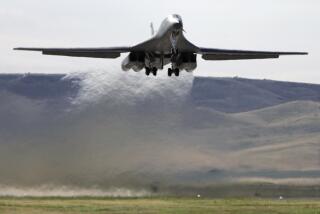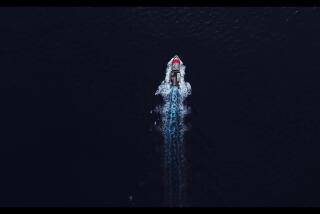At Long Last, Two WWII Pilots Are Coming Home
SAN CLEMENTE â When the taxicab pulled up in front of the Hadleysâ Kansas home, they sensed it was bad news. These were the early 1940s and America was at war.
âMy sister yelled to my mom, âThereâs a taxi here,â â recalled Bill Hadley, now 73, of Bartlesville, Okla. âThe cab driver handed my mother a telegram notifying us that my brother had died in the war.â
Bill Hadleyâs brother, Lt. Gilbert Hadley, was a handsome 22-year-old Kansan known for wearing cowboy boots and toting pearl-handled pistols on the missions he piloted.
Along with another crewman, Hadley was killed when their B-24 bomber crashed in the Mediterranean Sea off the coast of Turkey.
His body was never recovered, and Hadley never had a real funeral. Instead, the family erected a headstone over an empty plot for the fallen aviator.
That was more than 53 years ago, and the story might have ended there if a San Clemente resident, Roy Newton, 72, hadnât become irritated by misinformation about the crash site that appeared in numerous articles and books published to commemorate the 50th anniversary of the end of World War II.
Newton probably had the best idea of where the plane had crashed. He was a crewman on the bomber, christened âHadleyâs Harem,â and was manning one of the planeâs .50-caliber machine guns when it went down.
As he read various accounts of the ill-fated mission, âI realized that no one had a detailed location of where the ship crashed,â said Newton, 72, a retired product designer. âI said, âDammit, Iâm going to Turkey . . . to find that thing.â â
*
His quest actually began in Arizona at a reunion of his 98th Bomber Group, one of five that took part in the Aug. 1, 1943, raid that was supposed to destroy the vital Nazi-held oil fields at Ploesti, Romania.
At the reunion, he encountered two of the seven survivors of the crash who were still living. In all, the bomber had a crew of 10. The bombardier had been killed by antiaircraft fire that blew out the planeâs nose and crippled two of the shipâs four engines.
âWe were two to three miles from our target, flying about 50 feet off the ground when we got hit,â Newton remembers. âWe couldnât turn because we were in a tight formation with other planes, so we kept flying, powering up to clear smokestacks 200 feet tall.â
Lt. Hadley and the co-pilot, James âRexâ Lindsey of Texarkana, Texas, pointed the damaged bird toward Cyprus, then veered toward Turkey. They jettisoned their bombs, then ordered the crew to get rid of everything else, fire extinguishers, Mae West life preservers, parachutes, anything to lighten the airship, which was now struggling on two engines.
âWe got 25 miles off the coast of Turkey and were flying barely above stall speed,â Newton recalled. âHadley turned left toward land, it was about 8 oâclock at night and we were losing oil pressure and altitude.â
Newton remembers Hadley asking his fellow crew members, âYou wanna try the beach? Or the water?â
Suddenly, the two remaining engines froze and the ship plunged 150 feet, hitting the water nose first and breaking into three pieces.
*
Although Hadley and Lindsey never emerged from the sinking wreckage and presumably drowned, seven crewmen survived the crash. Among them was Newton, who suffered a broken leg. Using a small oxygen bottle as a buoy, he drifted in the ocean for four hours before reaching the shore, where he was rescued by a Turk who carried him two miles to a village.
For 50 years, Newton put his brush with death out of his mind. âI never thought of it as such a big deal,â he said. âIn those days, someone else always had a horror story worse than yours.â
But after the reunion, he got his hands on some navigation charts and plotted Hadleyâs course. He decided that he would find the B-24.
He traveled to Turkey, where a local newspaper published an article about his quest, but he didnât have much luck with his actual search. But after he returned to the United States he was contacted by a retired Turkish marine photographer who told him he saw the story and knew where to find the B-24.
âThe man said that he and his sons had been diving down to the B-24 for 20 years,â Newton said.
Based on the new lead, Newton revisited Turkey, hired divers and a boat, and motored to the location with the Turkish photographer.
âWhen we got over the site I nearly had a heart attack I was so excited,â Newton said. But foul weather had muddied the usually clear seas, and âwe couldnât see anything from the surface.â
Eventually, the wreckage was found in 110 feet of water, itâs nose partly buried. Several items were recovered from the wreckage, and when the parts were verified as coming from the B-24, it was a hopeful sign.
*
But Newton said the hardest part was still ahead.
Negotiations with the Turkish government for a permit to claim the plane were difficult, and the expenses, which Newton was absorbing, were mounting. Also, Newton had to come up with a plan to recover the nose section.
On his third trip, Newton invited Peter Frizzell, 41, a Florida history buff who is producing a film on the Ploesti raid. Frizzell became head of the recovery operation that involved bringing the planeâs nose up with large, inflated balloons.
Although it took more than a month and a half, they succeeded. Not only was the front section intact, they also recovered the remains of Hadley and Lindsey. In addition, they found Hadleyâs aviator sunglasses, his wristwatch and one of his pearl-handled 45-caliber pistols.
After finding the plane, Newton didnât immediately contact the families. He and Frizzell handed over the remains they had recovered to the U.S. Embassy in Turkey, which identified the bodies and notified the families.
Bill Hadley is thankful that Newton intervened.
âAfter all these years,â Bill Hadley said, âit was very difficult to believe that it was possible.â
As a result, two military burials are planned. The first will occur on Jan. 5 in Texas for Lindseyâs relatives. The second is on Jan. 9, in Arkansas City, Kan., where Bill Hadley and surviving relatives will finally bury his brother with a full military funeral.
(BEGIN TEXT OF INFOBOX / INFOGRAPHIC)
Lost and Found
Bomber was in 110 feet of water.
More to Read
Sign up for Essential California
The most important California stories and recommendations in your inbox every morning.
You may occasionally receive promotional content from the Los Angeles Times.










